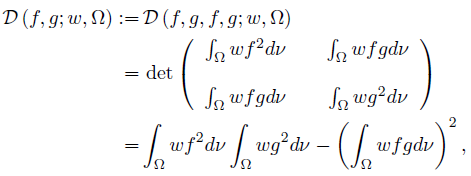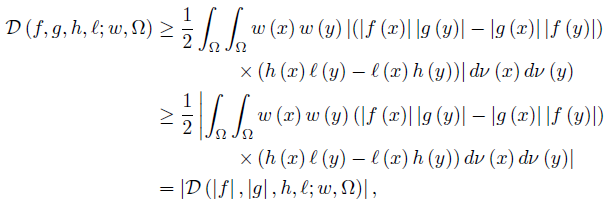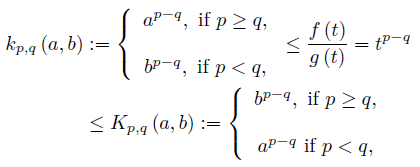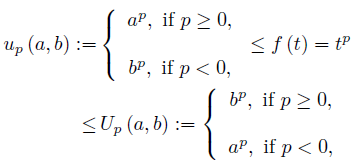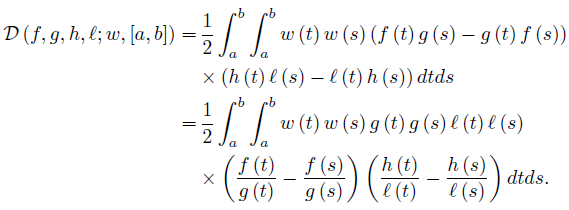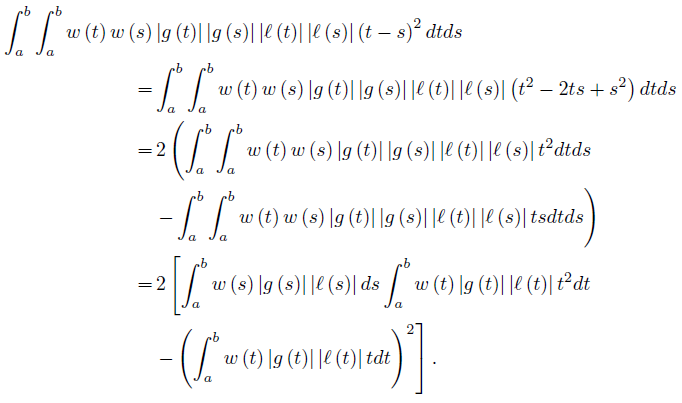1. Introduction
Let (Ω, A, ν) be a measurable space consisting of a set Ω, a σ-algebra A of subsets of Ω and a countably additive and positive measure ν on A with values in [0, +∞] . For a ν-measurable function w : Ω →  , with w (x) ≥ 0 for ν-a.e. (almost every) x ∈ Ω, consider the Lebesgue space
, with w (x) ≥ 0 for ν-a.e. (almost every) x ∈ Ω, consider the Lebesgue space
For simplicity of notation we write everywhere in the sequel  wdν instead of
wdν instead of  w (x) dν (x). Assume also that
w (x) dν (x). Assume also that  wdν = 1.
wdν = 1.
We say that the pair of measurable functions (f, g) are synchronous on Ω if
for ν-a.e. x, y ∈ Ω. If the inequality reverses in (1), the functions are called asynchronous on Ω.
If (f, g) are synchronous on Ω and f, g, fg ∈ Lw (Ω, ν), then the following inequality, that is known in the literature as Chebyshev’s Inequality, holds:
where w (x) ≥ 0 for ν-a.e. (almost every) x ∈ Ω and  wdν = 1.
wdν = 1.
If f, g : Ω →  are ν-measurable functions and f, g, fg ∈ Lw(Ω, ν), then we may consider the Chebyshev functional
are ν-measurable functions and f, g, fg ∈ Lw(Ω, ν), then we may consider the Chebyshev functional
The following result is known in the literature as the Grüss inequality:
provided
for ν-a.e. x ∈ Ω.
The constant  is sharp in the sense that it cannot be replaced by a smaller quantity.
is sharp in the sense that it cannot be replaced by a smaller quantity.
If f ∈ Lw (Ω, ν), then we may define
The following refinement of Grüss inequality in the general setting of measure spaces is due to Cerone & Dragomir [1]:
Theorem 1.1. Let w, f, g: Ω →  be ν-measurable functions with w ≥ 0 ν-a.e. on Ω and
be ν-measurable functions with w ≥ 0 ν-a.e. on Ω and wdν = 1. If f, g, fg ∈ Lw (Ω, ν) and there exist constants δ, ∆ such that
wdν = 1. If f, g, fg ∈ Lw (Ω, ν) and there exist constants δ, ∆ such that
then we have the inequality
The constant is sharp in the sense that it cannot be replaced by a smaller quantity.
is sharp in the sense that it cannot be replaced by a smaller quantity.
Motivated by the above results, we introduce in this paper the concept of quadruple D−synchronous functions that generalizes the concept of a pair of synchronous functions, we establish an inequality similar to Chebyshev inequality and also provide some CauchyBunyakovsky-Schwarz type inequalities for a functional associated with this quadruple. Some applications for univariate functions of real variable are given. Discrete inequalities are also stated.
2. D−Synchronous functions
Let (Ω, A, ν) be a measurable space and f, g, h, ℓ : Ω →  be four ν-measurable functions on Ω.
be four ν-measurable functions on Ω.
Definition 2.1. The quadruple (f, g, h, ℓ) is called D−Synchronous (D−Asynchronous) on Ω if
for ν-a.e. (almost every) x, y ∈ Ω.
This concept is a generalization of synchronous functions, since for g = 1, ℓ = 1 the quadruple (f, g, h, ℓ) is D−Synchronous if, and only if, (f, h) is synchronous on Ω.
for ν-a.e. x, y ∈ Ω. So, if gℓ > 0 ν-a.e on Ω the quadruple (f, g, h, ℓ) is D−Synchronous if, and only if,  is synchronous on Ω.
is synchronous on Ω.
Theorem 2.2. Let f, g, h, ℓ: Ω →  be ν-measurable functions on Ω and such that the quadruple (f, g, h, ℓ) is D-Synchronous (D−Asynchronous), w ≥ 0 a.e. on Ω with
be ν-measurable functions on Ω and such that the quadruple (f, g, h, ℓ) is D-Synchronous (D−Asynchronous), w ≥ 0 a.e. on Ω with wdν = 1 and fh, gℓ, gh, f ℓ ∈ Lw
(Ω, ν). Then,
wdν = 1 and fh, gℓ, gh, f ℓ ∈ Lw
(Ω, ν). Then,
Proof. Since the quadruple (f, g, h, ℓ) is D−Synchronous, then
for ν-a.e. x, y ∈ Ω.
This is equivalent to
for ν-a.e. x, y ∈ Ω.
Multiply (12) by w (x) w (y) ≥ 0 to get
for ν-a.e. x, y ∈ Ω.
If we integrate the inequality (13) over x ∈ Ω, then we get
for ν-a.e. y ∈ Ω.
Finally, if we integrate the inequality (14) over y ∈ Ω, then we get
which is equivalent to the desired result (10).
Corollary 2.3. Let f, g, h, ℓ: Ω →  be ν-measurable functions on Ω and such that gℓ > 0 ν-a.e on Ω,
be ν-measurable functions on Ω and such that gℓ > 0 ν-a.e on Ω,  is synchronous (asynchronous) on Ω, w ≥ 0 a.e. on Ω with
is synchronous (asynchronous) on Ω, w ≥ 0 a.e. on Ω with wdν = 1 and fh, gℓ, gh, fℓ ∈ Lw (Ω, ν) ; then the inequality (10) is valid.
wdν = 1 and fh, gℓ, gh, fℓ ∈ Lw (Ω, ν) ; then the inequality (10) is valid.
Let f, g, h, ℓ : Ω →  be ν-measurable functions on Ω , w ≥ 0 a.e. on Ω with
be ν-measurable functions on Ω , w ≥ 0 a.e. on Ω with  wdν = 1 and fh, gℓ, gh, fℓ ∈ Lw (Ω, ν) ; then we can consider the functionals
wdν = 1 and fh, gℓ, gh, fℓ ∈ Lw (Ω, ν) ; then we can consider the functionals
and, for (f, g) = (h, ℓ),
provided f 2, g2 ∈ Lw (Ω, ν).
We can improve the inequality (10) as follows:
Theorem 2.4. Let f, g, h, ℓ: Ω →  be ν-measurable functions on Ω and such that the quadruple (f, g, h, ℓ) is D−Synchronous, w ≥ 0 a.e. on Ω with
be ν-measurable functions on Ω and such that the quadruple (f, g, h, ℓ) is D−Synchronous, w ≥ 0 a.e. on Ω with wdν = 1 and fh, gℓ, gh, fℓ ∈ Lw (Ω, ν) ; then,
wdν = 1 and fh, gℓ, gh, fℓ ∈ Lw (Ω, ν) ; then,
Proof. We use the continuity property of the modulus, namely
Since (f, g, h, ℓ) is D−Synchronous, then
for ν-a.e. x, y ∈ Ω.
As in the proof of Theorem 2.2, we have the identity
By using the identity (19) and the first branch in (18) we have
which proves the first part of (17).
The second and third part of (17) can be proved in a similar way and details are omitted.
3. Further results for the functional D
We have the following Schwarz’s type inequality for the functional D:
Theorem 3.1. Let f, g, h, ℓ: Ω →  be ν-measurable functions on Ω , w ≥ 0 a.e. on Ω with
be ν-measurable functions on Ω , w ≥ 0 a.e. on Ω with wdν = 1 and f2, g2, h2, ℓ2 ∈ Lw (Ω, ν). Then,
wdν = 1 and f2, g2, h2, ℓ2 ∈ Lw (Ω, ν). Then,
Proof. As in the proof of Theorem 2.4, we have the identities
and
By the Cauchy-Bunyakovsky-Schwarz double integral inequality we have
which produces the desired result (20).
Corollary 3.2. Let f, g, h, ℓ: Ω →  be ν-measurable functions on Ω with g2, ℓ2 ∈ Lw (Ω, ν), w ≥ 0 a.e. on Ω with
be ν-measurable functions on Ω with g2, ℓ2 ∈ Lw (Ω, ν), w ≥ 0 a.e. on Ω with wdν = 1, and a, A, b, B ∈
wdν = 1, and a, A, b, B ∈  such that A > a, B > b,
such that A > a, B > b,
ν-a.e. on Ω. Then,
Proof. In [2] (see also [4, p. 8]) we proved the following reverse of Cauchy-BunyakovskySchwarz integral inequality
provided that ag ≤ f ≤ Ag ν-a.e. on Ω and g2 ∈ Lw (Ω, ν).
Since, we also have
provided that bℓ ≤ h ≤ Bℓ ν-a.e. on Ω and ℓ2 ∈ Lw (Ω, ν). Then, by (20) we have
that is equivalent to the desired result (22).
For positive margins we also have:
Corollary 3.3. Let f, g, h, ℓ: Ω →  be four ν-measurable functions on Ω with g2, ℓ2 ∈ Lw (Ω, ν), w ≥ 0 a.e. on Ω with
be four ν-measurable functions on Ω with g2, ℓ2 ∈ Lw (Ω, ν), w ≥ 0 a.e. on Ω with wdν = 1, and a, A, b, B > 0 such that A > a, B > b,
wdν = 1, and a, A, b, B > 0 such that A > a, B > b,
ν-a.e. on Ω. Then we have
Proof. In [3] (see also [4, p. 16]) we proved the following reverse of Cauchy-BunyakovskySchwarz integral inequality:
whenever ag ≤ f ≤ Ag ν-a.e. on Ω.
Since
provided bℓ ≤ h ≤ Bℓ ν-a.e. on Ω, then by (20) we get the desired result (24).
If bounds for the sum and difference are available, then we have:
Corollary 3.4. Let f, g, h, ℓ : Ω →  be ν-measurable functions on Ω with g2 , ℓ2 ∈ Lw (Ω, ν), w ≥ 0 a.e. on Ω with
be ν-measurable functions on Ω with g2 , ℓ2 ∈ Lw (Ω, ν), w ≥ 0 a.e. on Ω with wdν = 1. Assume that there exists the constants P1, Q1, P2, Q2such that
wdν = 1. Assume that there exists the constants P1, Q1, P2, Q2such that
a.e. on Ω; then,
Proof. In the recent paper [5] we obtained amongst other the following reverse of CauchyBunyakovsky-Schwarz integral inequality:
provided |g − f| ≤ P1, |g + f| ≤ Q1 a.e. on Ω.
Since
if |h − ℓ| ≤ P2, |h + ℓ| ≤ Q2 a.e. on Ω, then by (20) we get the desired result (26).
If bounds for each function are available, then we have:
Corollary 3.5. Let f, g, h, ℓ: Ω →  be ν-measurable functions on Ω and w ≥ 0 a.e. on Ω with
be ν-measurable functions on Ω and w ≥ 0 a.e. on Ω with wdν = 1. Assume that there exists the constants ai, Ai , bi and Bi with i ∈ {1, 2} such that
wdν = 1. Assume that there exists the constants ai, Ai , bi and Bi with i ∈ {1, 2} such that
and
a.e. on Ω; then,
Proof. We use the following Ozeki’s type inequality obtained in [6]:
provided 0 < a1 ≤ f ≤ A1 < ∞, 0 < a2 ≤ g ≤ A2 < ∞ a.e. on Ω.
Since
when 0 < b1 ≤ h ≤ B1 < ∞, 0 < b2 ≤ ℓ ≤ B2 < ∞ a.e. on Ω, then by (20) we get the desired result (29).
4. Results for univariate functions
Let Ω = [a, b] be an interval of real numbers, and assume that f, g, h, ℓ : [a, b] →  are measurable D−Synchronous (D−Aynchronous), w ≥ 0 a.e. on [a, b] with
are measurable D−Synchronous (D−Aynchronous), w ≥ 0 a.e. on [a, b] with  w (t) dt = 1 and fh, gℓ, gh, fℓ ∈ Lw ([a, b]) ; then,
w (t) dt = 1 and fh, gℓ, gh, fℓ ∈ Lw ([a, b]) ; then,
Now, assume that [a, b] ⊂ (0, ∞) and take f (t) = tp, g (t) = tq, h (t) = tr and ℓ (t) = ts with p, q, r, s ∈  . Then,
. Then,
If (p − q) (r − s) > 0, then the functions  have the same monotonicity on [a, b] while if (p − q) (r − s) < 0 then
have the same monotonicity on [a, b] while if (p − q) (r − s) < 0 then  have opposite monotonicity on [a, b] . Therefore, by (30) we have for any nonnegative integrable function w with
have opposite monotonicity on [a, b] . Therefore, by (30) we have for any nonnegative integrable function w with  w (t) dt = 1 that
w (t) dt = 1 that
provided (p − q) (r − s) > (<) 0.
Assume that [a, b] ⊂ (0, ∞) and take f (t) = exp (αt), g (t) = exp (βt), h (t) = exp (γt) and ℓ (t) = exp (δt), with α, β, γ, δ ∈  . Then,
. Then,
If (α − β) (γ − δ) > 0, then the functions  have the same monotonicity on [a, b] , while if (α − β) (γ − δ) < 0 then
have the same monotonicity on [a, b] , while if (α − β) (γ − δ) < 0 then  have opposite monotonicity on [a, b] . Therefore, by (30) we have for any nonnegative integrable function w with
have opposite monotonicity on [a, b] . Therefore, by (30) we have for any nonnegative integrable function w with  w (t) dt = 1 that
w (t) dt = 1 that
provided (α − β) (γ − δ) > (<) 0.
Consider the functional
for any nonnegative integrable function w with  w (t) dt = 1, and p, q, r, s ∈
w (t) dt = 1, and p, q, r, s ∈  .
.
We observe that for t ∈ [a, b] ⊂ (0, ∞) we have
and, similarly,
Using the inequality (22) we have
while from (24) we have
We also have for t ∈ [a, b] ⊂ (0, ∞) that
and the corresponding bounds for g (t) = tq, h (t) = tr and ℓ (t) = ts, with p, q, r, s ∈  . Making use of the inequality (29) we get
. Making use of the inequality (29) we get
Similar results may be stated for the functional
for any nonnegative integrable function w with  w (t) dt = 1, for α, β, γ, δ ∈
w (t) dt = 1, for α, β, γ, δ ∈  and [a, b] ⊂ (0, ∞). Details are omitted.
and [a, b] ⊂ (0, ∞). Details are omitted.
We say that the function φ : [a, b] →  is Lipschitzian with the constant L > 0 if
is Lipschitzian with the constant L > 0 if
for any t, s ∈ [a, b] .
Define the functional
In the next result we provided two upper bounds in terms of Lipschitzian constants:
Theorem 4.1. Let f, g, h, ℓ: [a, b] →  be measurable functions and w ≥ 0 a.e. on [a, b] with
be measurable functions and w ≥ 0 a.e. on [a, b] with w (t) dt = 1.
w (t) dt = 1.
(i) If g (t), ℓ (t)  0 for any t ∈ [a, b] , and
0 for any t ∈ [a, b] , and is Lipschitzian with the constant L > 0, and is Lipschitzian with the constant K
is Lipschitzian with the constant L > 0, and is Lipschitzian with the constant K > 0, and gℓ, gℓe2 ∈ Lw ([a, b]) with e (t) = t, t ∈ [a, b], then
> 0, and gℓ, gℓe2 ∈ Lw ([a, b]) with e (t) = t, t ∈ [a, b], then
(ii) If, in addition, we have wgℓ ∈ L∞ [a, b] and
then
Proof. We have
By taking modulus in this equality, we get
Now, observe that
On making use of (40) and (41) we get the desired result (38).
If wgℓ ∈ L∞ [a, b] , then
Therefore, by inequalities (40) and (42) we obtain the desired result (39).
5. Discrete inequalities
Consider the n-tuples of real numbers x = (x1, ..., xn), y = (y1, ..., yn), z = (z1, ..., zn) and u = (u1, ..., un). We say that the quadruple (x, y, z, u) is D−Synchronous if
for any i, j ∈ {1, ..., n} .
If p = (p1, ..., pn) is a probability distribution, namely, pi
≥ 0 for any i ∈ {1, ..., n} and  =1 pi = 1, and the quadruple (x, y, z, u) is D−Synchronous, then by (10) we have:
=1 pi = 1, and the quadruple (x, y, z, u) is D−Synchronous, then by (10) we have:
For an n-tuples of real numbers x = (x1, ..., xn), we denote by |x| := (|x1| , ..., |xn|). On making use of the inequality (17), then for any D−Synchronous quadruple (x, y, z, u) and for any probability distribution p = (p1, ..., pn) we have
Observe that if we consider
then by (20) we have
for any quadruple (x, y, z, u) and any probability distribution p = (p1, ..., pn).
If a, A, b, B ∈  and (x, y, z, u) are such that A > a, B > b,
and (x, y, z, u) are such that A > a, B > b,
for any i ∈ {1, ..., n} , then by (22) we have
If a, A, b, B > 0 and condition (47) is valid, then by (24) we have
Now, if we use the Klamkin-McLenaghan’s inequality
that holds for x, y satisfying the condition (47) with A, a > 0, then by (46) we get
provided (x, y, z, u) satisfy (47) with a, A, b, B > 0.
Now, assume that
and
for any i ∈ {1, ..., n} ; then by (29) we get
for any probability distribution p = (p1, ..., pn ).
































